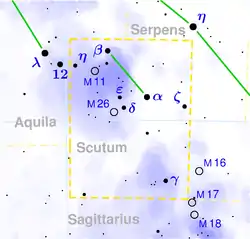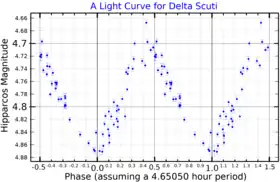Delta Scuti
Delta Scuti, Latinized from δ Scuti, is a variable star in the southern constellation Scutum. With an apparent visual magnitude that fluctuates around 4.72,[4] it is the fifth-brightest star in this small and otherwise undistinguished constellation. Analysis of the parallax measurements place this star at a distance of about 199 light-years (61 parsecs) from Earth.[1] It is drifting closer with a radial velocity of −45 km/s.[5]
 | |
| Observation data Epoch J2000 Equinox J2000 | |
|---|---|
| Constellation | Scutum |
| Right ascension | 18h 42m 16.42705s[1] |
| Declination | −09° 03′ 09.2004″[1] |
| Apparent magnitude (V) | 4.60 - 4.79[2] |
| Characteristics | |
| Spectral type | F2 IIIp[3] |
| U−B color index | +0.16[4][2] |
| B−V color index | +0.35[4] |
| Variable type | δ Sct[2] |
| Astrometry | |
| Radial velocity (Rv) | −45.1±0.6[5] km/s |
| Proper motion (μ) | RA: 7.175[1] mas/yr Dec.: 1.996[1] mas/yr |
| Parallax (π) | 16.3644 ± 0.2022 mas[1] |
| Distance | 199 ± 2 ly (61.1 ± 0.8 pc) |
| Absolute magnitude (MV) | 0.72±0.04[6] |
| Details | |
| Mass | 2.23+0.06 −0.05[7] M☉ |
| Radius | 4.78±0.38[1] R☉ |
| Luminosity | 40.0±0.6[1] L☉ |
| Surface gravity (log g) | 3.5[8] cgs |
| Temperature | 6,638+277 −247[1] K |
| Metallicity [Fe/H] | 0.41[6] dex |
| Rotational velocity (v sin i) | 25.5[8] km/s |
| Age | 0.7±0.1[6] Gyr |
| Other designations | |
| Database references | |
| SIMBAD | data |
In 1900, William W. Campbell and William H. Wright used the Mills spectrograph at the Lick Observatory to determine that this star has a variable radial velocity.[10] The 0.19377 days (4.650 h) period of this variability as well as 0.2 magnitude changes in luminosity demonstrated in 1935 that the variability was intrinsic, rather than being the result of a spectroscopic binary.[11] In 1938, a secondary period was discovered and a pulsation theory was proposed to model the variation.[12] Since then, observation of Delta Scuti has shown that it pulsates in multiple discrete radial and non-radial modes. The strongest mode has a frequency of 59.731 μHz, the next strongest has a frequency of 61.936 μHz, and so forth, with a total of eight different frequency modes now modeled.[13]

Delta Scuti is the prototype of the Delta Scuti type variable stars. It is a high-amplitude δ Scuti type pulsator with light variations of about 0.19 magnitudes (V).[15] The peculiar chemical abundances of this star are similar to those of Am stars.[8] It has a stellar classification of F2 IIIp,[3] matching an F-type giant star. Delta Scuti has 2.2[7] times the mass and 4.8[1] times the radius of the Sun. It is approximately 700 million years old and is spinning with a projected rotational velocity of 25.5 km/s.[8] On average, the star is radiating 40 times the luminosity of the Sun from its photosphere at an effective temperature of 6,638 K.[1]
The space velocity components of this star in the galactic coordinate system are [U, V, W] = [−42, −17, −1] km·s−1. It is following an orbit through the Milky Way galaxy that has an eccentricity of 0.11, carrying it as close as 22.31 kly (6.84 kpc) to, and as far as 27.59 kly (8.46 kpc) from the Galactic Center.[6] If Delta Scuti maintains its current movement and brightness, it will pass within 10 light-years of the Solar System,[16] becoming the brightest star in the sky between 1150000 and 1330000 CE. It will reach an apparent magnitude of −1.84, brighter than the current −1.46 of Sirius.[17][18]
This star has two optical companions. The first is a +12.2 magnitude star that is 15.2 arcseconds from Delta Scuti. The second is a +9.2 magnitude star that is 53 arcseconds away.[19] Both are distant background stars unrelated to Delta Scuti.[20]
Flamsteed did not recognise the constellation Scutum and included several of its stars in Aquila. δ Scuti was catalogued as 2 Aquilae. The Bayer designation δ was assigned by Gould rather than Bayer.[21]
References
- Brown, A. G. A.; et al. (Gaia collaboration) (August 2018). "Gaia Data Release 2: Summary of the contents and survey properties". Astronomy & Astrophysics. 616. A1. arXiv:1804.09365. Bibcode:2018A&A...616A...1G. doi:10.1051/0004-6361/201833051. Gaia DR2 record for this source at VizieR.
- Samus, N. N.; Durlevich, O. V.; et al. (2009). "VizieR Online Data Catalog: General Catalogue of Variable Stars (Samus+ 2007-2013)". VizieR On-line Data Catalog: B/GCVS. Originally Published in: 2009yCat....102025S. 1. Bibcode:2009yCat....102025S.
- Cowley, Anne; Fraquelli, Dorothy (February 1974). "MK Spectral Types for Some Bright F Stars". Publications of the Astronomical Society of the Pacific. 86 (509): 7. Bibcode:1974PASP...86...70C. doi:10.1086/129562.
- Johnson, H. L.; et al. (1966). "UBVRIJKL photometry of the bright stars". Communications of the Lunar and Planetary Laboratory. 4 (99): 99. Bibcode:1966CoLPL...4...99J.
- Gontcharov, G. A. (November 2006). "Pulkovo Compilation of Radial Velocities for 35495 Hipparcos stars in a common system". Astronomy Letters. 32 (11): 759–771. arXiv:1606.08053. Bibcode:2006AstL...32..759G. doi:10.1134/S1063773706110065. S2CID 119231169.
- Holmberg, J.; Nordström, B.; Andersen, J. (July 2009). "The Geneva-Copenhagen survey of the solar neighbourhood. III. Improved distances, ages, and kinematics". Astronomy and Astrophysics. 501 (3): 941–947. arXiv:0811.3982. Bibcode:2009A&A...501..941H. doi:10.1051/0004-6361/200811191. S2CID 118577511.
- Nordström, B.; et al. (May 2004). "The Geneva-Copenhagen survey of the Solar neighbourhood. Ages, metallicities, and kinematic properties of ˜14 000 F and G dwarfs". Astronomy and Astrophysics. 418: 989–1019. arXiv:astro-ph/0405198. Bibcode:2004A&A...418..989N. doi:10.1051/0004-6361:20035959. S2CID 11027621.
- Yushchenko, A.; et al. (May 2005). "The chemical composition of δ Scuti". Monthly Notices of the Royal Astronomical Society. 359 (55): 865–873. Bibcode:2005MNRAS.359..865Y. doi:10.1111/j.1365-2966.2005.08921.x.
- "del Sct – Variable star of delta Sct type". SIMBAD Astronomical Object Database. Centre de Données astronomiques de Strasbourg. Retrieved 2009-10-23.
- Campbell, W. W.; Wright, W. H. (1900). "A list of nine stars whose velocities in the line of sight are variable". Astrophysical Journal. 12: 254–257. Bibcode:1900ApJ....12..254C. doi:10.1086/140765. Listed as 2 Scuti on p. 256.
- Colacevich, A. (August 1935). "On the variable radial velocity of δ Scuti". Publications of the Astronomical Society of the Pacific. 47 (278): 231–232. Bibcode:1935PASP...47..231C. doi:10.1086/124599.
- Sterne, T. E. (March 1938). "The Secondary Variation of δ Scuti". Astrophysical Journal. 87: 133–150. Bibcode:1938ApJ....87..133S. doi:10.1086/143913.
- Templeton, Matthew R.; et al. (October 1997). "A New Pulsation Spectrum and Asteroseismology of delta Scuti". The Astronomical Journal. 114: 1592–1601. Bibcode:1997AJ....114.1592T. doi:10.1086/118590.
- "Light Curve". Hipparcos ESA. ESA. Retrieved 31 August 2022.
- "del Sct". International Variable Star Index. AAVSO. Retrieved 29 August 2022.
- García-Sánchez, J.; et al. (2001). "Stellar encounters with the solar system". Astronomy and Astrophysics. 379 (2): 634–659. Bibcode:2001A&A...379..634G. doi:10.1051/0004-6361:20011330.
- Sky and Telescope, April 1998 (p60), based on computations from Hipparcos mission data.
- Tomkin, Jocelyn (April 1998). "Once and Future Celestial Kings". Sky and Telescope. 95 (4): 59–63. Bibcode:1998S&T....95d..59T. – based on computations from HIPPARCOS data. (The calculations exclude stars whose distance or proper motion is uncertain.) PDF
- Burnham, Robert (1978). Burnham's celestial handbook: an observer's guide to the universe beyond the solar system. Vol. 3. Courier Dover Publications. p. 1746. ISBN 0-486-23673-0.
- Vallenari, A.; et al. (Gaia collaboration) (2023). "Gaia Data Release 3. Summary of the content and survey properties". Astronomy and Astrophysics. 674: A1. arXiv:2208.00211. Bibcode:2023A&A...674A...1G. doi:10.1051/0004-6361/202243940. S2CID 244398875.
- Wagman, M. (August 1987). "Flamsteed's Missing Stars". Journal for the History of Astronomy. 18 (3): 212. Bibcode:1987JHA....18..209W. doi:10.1177/002182868701800305. S2CID 118445625.